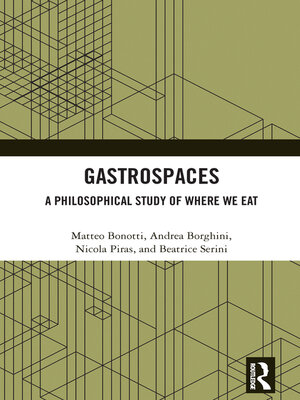Gastrospaces
ebook ∣ A Philosophical Study of Where We Eat · Critical Food Studies
By Matteo Bonotti

Sign up to save your library
With an OverDrive account, you can save your favorite libraries for at-a-glance information about availability. Find out more about OverDrive accounts.
Find this title in Libby, the library reading app by OverDrive.



Search for a digital library with this title
Title found at these libraries:
| Library Name | Distance |
|---|---|
| Loading... |
This book explores the moral and political significance of gastrospaces: the spaces where we eat. It adopts an innovative approach, combining analytic political philosophy and analytic ontology, to lay down the theoretical foundations for a multi- and interdisciplinary research agenda on the complex interconnections between food and space.
Social science and humanities scholars have studied the ties between food consumption and space from multiple angles. This book sets up a different and more foundational approach, which engages with these bodies of work and integrates them into a coherent framework. While taking the reader through a theoretical journey of varying complexities, the book also illustrates the social, political, and cultural significance of gastrospaces by surveying an array of examples from diverse historical and geographical contexts. It then draws on political philosophy to show that gastrospaces are sites of justice and injustice and complements this analysis by developing an ontological model for gastrospaces that facilitates a systematic analysis of their social, political, and cultural significance. The book ends with a toolbox for the study of gastrospaces that different stakeholders may apply to their respective contexts of intervention.
This book will appeal to philosophers, political scientists, food scholars, geographers, and anyone interested in the intersection between food and space. By focusing on a wide range of real-world topics related to gastrospaces, such as racist dress codes, family-friendly restaurants, speakeasies, and gendered kitchen designs, the book will also be of interest to nonacademic stakeholders such as urban planners, policymakers, designers, managers, and consumers.







